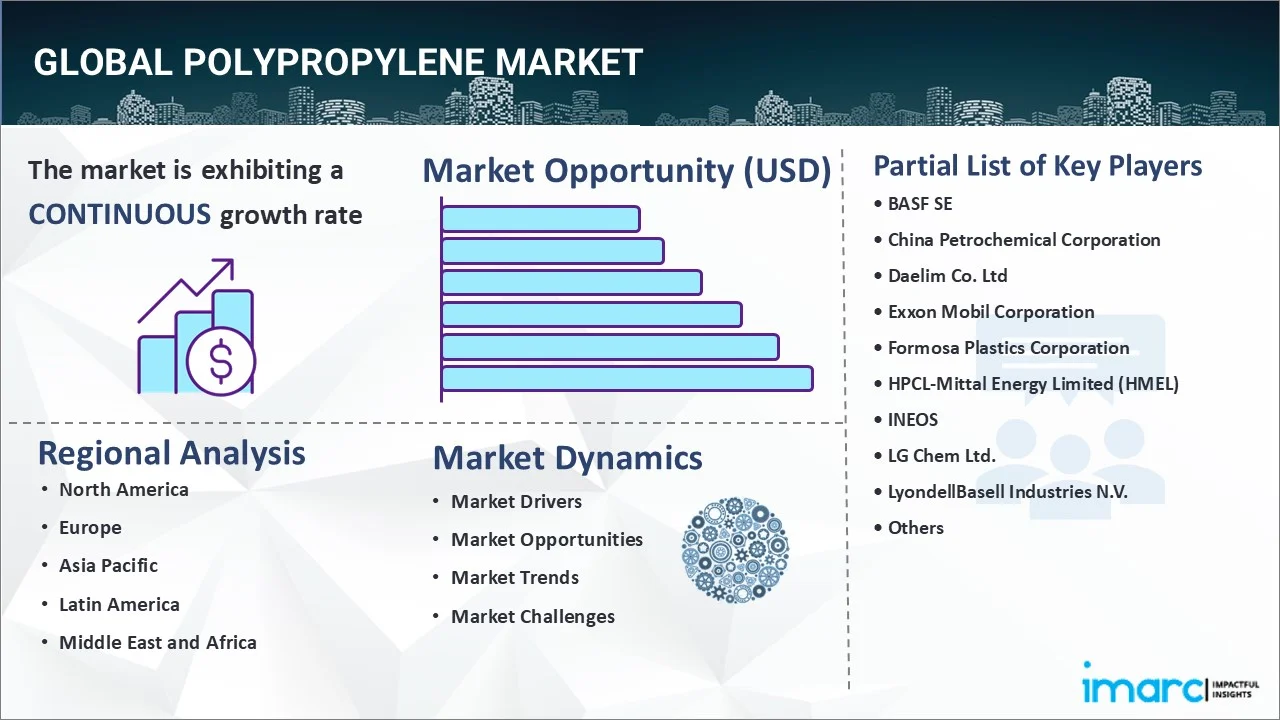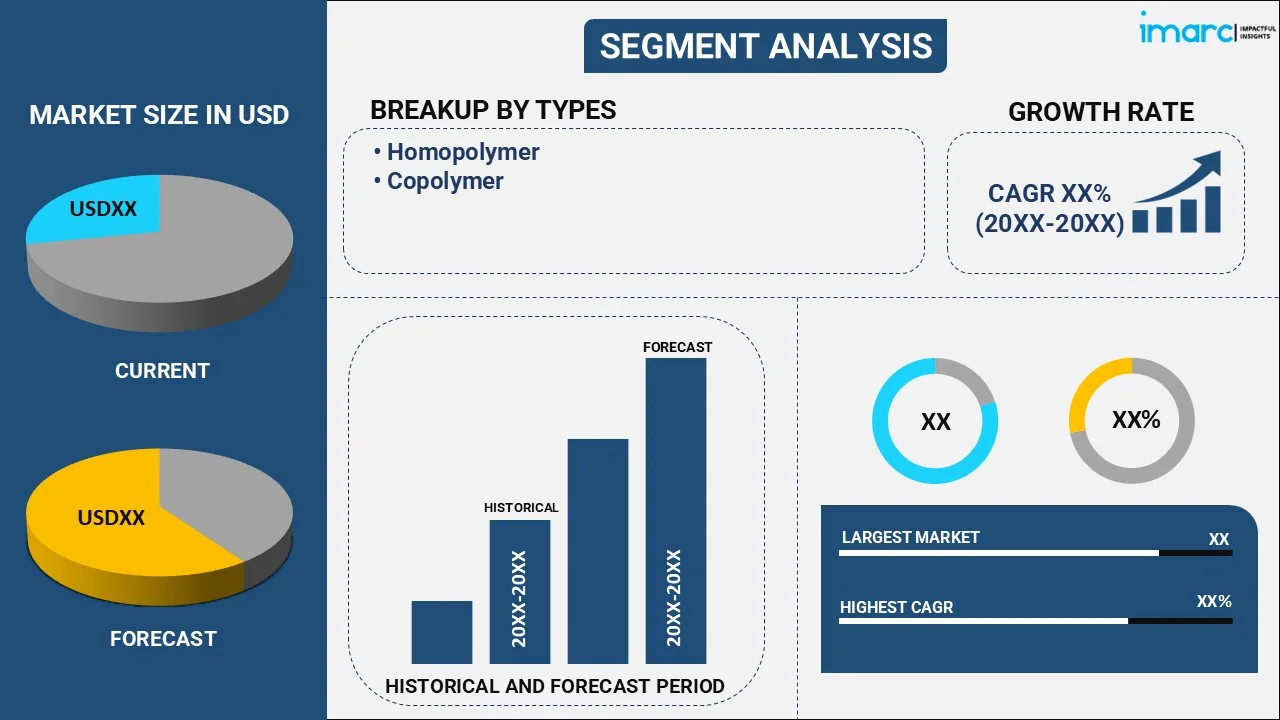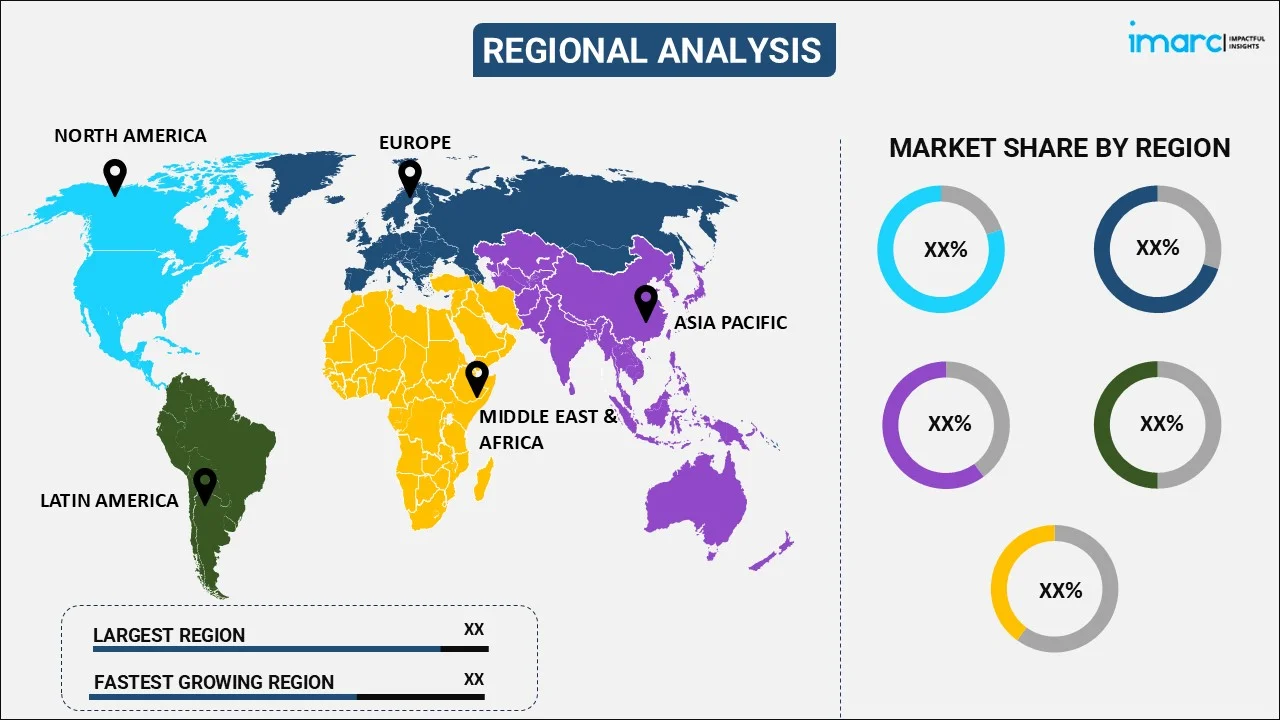
Polypropylene Market Report by Type (Homopolymer, Copolymer), Process (Injection Molding, Blow Molding, Extrusion, and Others), Application (Film and Sheet, Fiber, Raffia, and Others), End User (Packaging, Automotive, Building and Construction, Medical, Electrical and Electronics, and Others), and Region 2025-2033
Polypropylene Market Size:
The global polypropylene market size reached USD 136.5 Billion in 2024. Looking forward, IMARC Group expects the market to reach USD 184.1 Billion by 2033, exhibiting a growth rate (CAGR) of 3.21% during 2025-2033. The market is driven by increasing demand in packaging, the thriving automotive industry, and rising number of residential and commercial spaces. At present, Asia Pacific holds the largest market share on account of rapid urbanization and favorable government initiatives.
|
Report Attribute
|
Key Statistics
|
|---|---|
|
Base Year
|
2024
|
|
Forecast Years
|
2025-2033
|
|
Historical Years
|
2019-2024
|
|
Market Size in 2024
|
USD 136.5 Billion |
|
Market Forecast in 2033
|
USD 184.1 Billion |
| Market Growth Rate 2025-2033 | 3.21% |
Polypropylene (C3H6)n, also known as polypropene, is a flexible and crystalline thermoplastic resin obtained by the polymerization reaction of propylene gas and a catalyst. It provides resistance against chemicals, heat, and extreme temperatures, which makes it safe to design plastic casings in electrical appliances, cables, and piping systems. Additionally, its flexible strength and resistance to moisture, bacteria, mold, and chemical corrosion make it ideal for medical applications, especially sterilization methods. At present, it is widely used in injection molding applications as (C3H6)n is easily molded into different shapes without altering the original product quality.

Polypropylene Market Trends:
Growing Demand in Packaging
There is a rise in the demand for polypropylene as a packaging essential in the e-commerce, retail, and food and beverage (F&B) industries. Polypropylene is commonly utilized in both flexible and rigid packaging due to its durability, lightweight characteristics, resistance to moisture, and capacity to maintain food freshness. There is an increase in the emphasis on eco-friendly packaging that reduces environmental harm. In addition, the toughness and affordability of polypropylene makes it the preferred material for a range of packaging options such as containers, films, and caps. The demand for polypropylene is further propelled by the focus on convenience, portability, and sustainability, particularly in areas like Asia-Pacific, where there is urbanization and population growth. People are preferring plastic packaging as they offer enhanced sturdiness. The research report of the IMARC Group states that the global plastic packaging market is projected to record USD 516.3 Billion in 2032.
Automotive Industry Growth
The demand for polypropylene is largely driven by the automotive industry's move toward lightweight materials. Since polypropylene is strong, flexible, and lightweight, it is frequently used in automotive parts like dashboards, door panels, bumpers, and interior trims. Polypropylene market share is rising as producers strive to fulfill stricter emissions and fuel economy regulations. Vehicle weight reduction increases fuel economy and aids manufacturers in meeting environmental standards. The cost-effectiveness and recyclability of polypropylene add to its appeal for use in automotive applications. In addition, the rising adoption of electric vehicles (EVs) due to concerns among individuals about environment is bolstering the market growth. Governing agencies of various countries are also encouraging the adoption of EVs owing to their ability to maintain environmental sustainability. The International Energy Association (IEA) predicts that by the end of 2024, there will be 17 million EVs sold worldwide.
Construction Sector Expansion
The thriving construction industry is driving up the demand for polypropylene, particularly for roofing, insulation, and pipe applications. Polypropylene is a great material for building because of its weatherproofing properties, chemical resistance, and durability properties. The rising need for residential and commercial spaces as a result of rapid urbanization is impelling the polypropylene market growth. Because of its energy-efficient production methods and recyclability, polypropylene is also preferred for green building techniques. Furthermore, geotextiles based on polypropylene are frequently utilized in civil engineering projects to stabilize soil and stop erosion. By letting water through while holding onto soil particles, polypropylene geotextiles function as a protective layer, stabilizing landscapes while lowering the chance of landslides or washouts. As per the Invest India, the construction industry in India is expected to hit USD 1.4 Trillion by 2025.
Polypropylene Market Segmentation:
IMARC Group provides an analysis of the key trends in each segment of the market, along with forecasts at the global, regional, and country levels for 2025-2033. Our report has categorized the market based on type, process, application, and end user.
Breakup by Type:

- Homopolymer
- Copolymer
Breakup by Process:
- Injection Molding
- Blow Molding
- Extrusion
- Others
Breakup by Application:
- Film and Sheet
- Fiber
- Raffia
- Others
Breakup by End User:
- Packaging
- Automotive
- Building and Construction
- Medical
- Electrical and Electronics
- Others
Breakup by Region:

- North America
- United States
- Canada
- Asia-Pacific
- China
- Japan
- India
- South Korea
- Australia
- Indonesia
- Others
- Europe
- Germany
- France
- United Kingdom
- Italy
- Spain
- Russia
- Others
- Latin America
- Brazil
- Mexico
- Others
- Middle East and Africa
Competitive Landscape:
The global polypropylene market research report has also provided a comprehensive analysis of the competitive landscape. Detailed profiles of all major companies have also been provided. Some of the companies covered include:
- BASF SE
- China Petrochemical Corporation
- Daelim Co. Ltd
- Exxon Mobil Corporation
- Formosa Plastics Corporation
- HPCL-Mittal Energy Limited (HMEL)
- INEOS
- LG Chem Ltd.
- LyondellBasell Industries N.V.
- Saudi Basic Industries Corporation (Saudi Arabian Oil Co.)
- Sumitomo Chemical Co. Ltd.
- TotalEnergies SE
- Trinseo PLC
- Westlake Corporation
Kindly note that this only represents a partial list of companies, and the complete list has been provided in the report.
Polypropylene Market News:
- 30 June 2023: Borealis inked a deal to buy Rialti, one of the top manufacturers of mechanically recovered polypropylene compounds for extrusion and injection molding.
- 19 January 2023: Governor John Bel Edwards joined ExxonMobil to celebrate the start of the Polypropylene Growth Project (PPG Project) activities. Through the project, ExxonMobil will be able to double its production capacity of polypropylene, or 450,000 metric tons annually, meeting the need for strong and high-performing polymers.
- 22 August 2024: Petronet LNG Ltd. awarded Lummus Technology. Lummus' Novolen polypropylene (PP) technology will be licensed by Petronet for use in a new 500 KTA plant located in Dahej, Gujarat, India.
Polypropylene Market Report Scope:
| Report Features | Details |
|---|---|
| Base Year of the Analysis | 2024 |
| Historical Period | 2019-2024 |
| Forecast Period | 2025-2033 |
| Units | Billion USD |
| Segment Coverage | Type, Process, Application, End User, Region |
| Region Covered | Asia Pacific, Europe, North America, Latin America, Middle East and Africa |
| Countries Covered | United States, Canada, Germany, France, United Kingdom, Italy, Spain, Russia, China, Japan, India, South Korea, Australia, Indonesia, Brazil, Mexico |
| Companies Covered | BASF SE, China Petrochemical Corporation, Daelim Co. Ltd, Exxon Mobil Corporation, Formosa Plastics Corporation, HPCL-Mittal Energy Limited (HMEL), INEOS, LG Chem Ltd., LyondellBasell Industries N.V., Saudi Basic Industries Corporation (Saudi Arabian Oil Co.), Sumitomo Chemical Co. Ltd., TotalEnergies SE, Trinseo PLC, Westlake Corporation. |
| Customization Scope | 10% Free Customization |
| Post-Sale Analyst Support | 10-12 Weeks |
| Delivery Format | PDF and Excel through Email (We can also provide the editable version of the report in PPT/Word format on special request) |
Key Questions Answered in This Report:
- How has the global polypropylene market performed so far and how will it perform in the coming years?
- What has been the impact of COVID-19 on the global polypropylene market?
- What are the key regional markets?
- What is the breakup of the market based on the type?
- What is the breakup of the market based on the process?
- What is the breakup of the market based on the application?
- What is the breakup of the market based on the end user?
- What are the various stages in the value chain of the industry?
- What are the key driving factors and challenges in the industry?
- What is the structure of the global polypropylene market and who are the key players?
- What is the degree of competition in the industry?
Need more help?
- Speak to our experienced analysts for insights on the current market scenarios.
- Include additional segments and countries to customize the report as per your requirement.
- Gain an unparalleled competitive advantage in your domain by understanding how to utilize the report and positively impacting your operations and revenue.
- For further assistance, please connect with our analysts.
 Inquire Before Buying
Inquire Before Buying
 Speak to an Analyst
Speak to an Analyst
 Request Brochure
Request Brochure
 Request Customization
Request Customization




.webp)




.webp)












